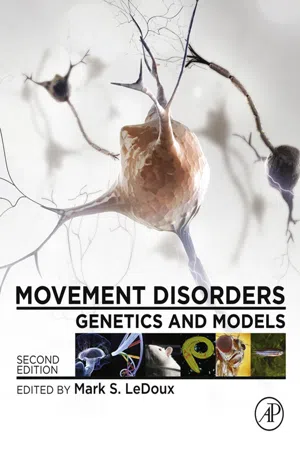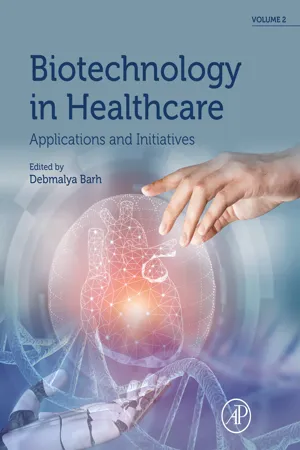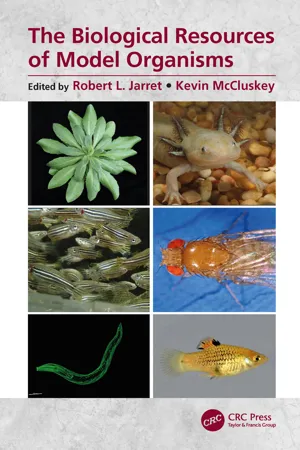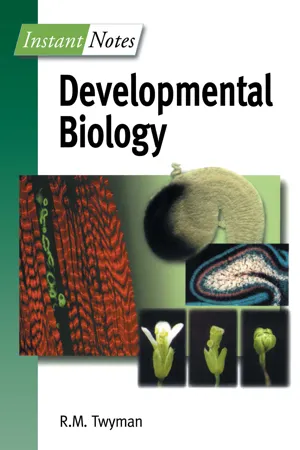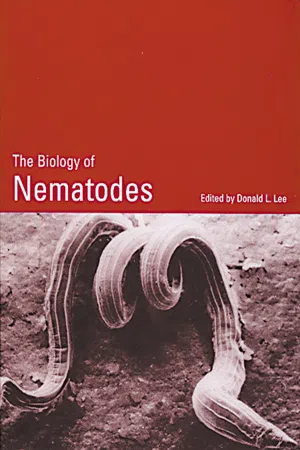Biological Sciences
C Elegans
C. elegans is a species of roundworm commonly used as a model organism in biological research. It has a simple and well-defined anatomy, a short lifespan, and a fully sequenced genome, making it an ideal subject for studying various biological processes. Its transparency allows for easy observation of internal structures, and its genetic makeup shares similarities with higher organisms, making it a valuable tool for understanding fundamental biological principles.
Written by Perlego with AI-assistance
9 Key excerpts on "C Elegans"
- eBook - ePub
Movement Disorders
Genetics and Models
- Mark S. LeDoux(Author)
- 2014(Publication Date)
- Academic Press(Publisher)
Chalfie et al., 1994 ; Fire et al., 1998 ) and Nobel Prizes duly awarded. In 2006, the Nobel Prize in Physiology or Medicine was awarded to Andrew Fire and Craig Mello for discovering RNAi. Finally, one of the recipients of the 2008 Nobel Prize in Chemistry was a C. elegans neurogeneticist, Martin Chalfie, who popularized the use the GFP in live cells.The ability to rapidly perturb behaviors or assess cellular activity, in the context of an intact animal with defined neuronal processes, is highly advantageous for directly linking genetic abnormality to anatomical structure and protein function. In this regard, multiple investigators as well as biotechnology companies are currently exploiting C. elegans for the insights it may provide into disease mechanisms related to human movement disorders. Here, we attempt to provide an overview of some important resources and recent work in the development of worm models for probing the function of gene products implicated in specific movement disorders.6.2. Caenorhabditis elegans Web-Based Resources
Several general information resources are available online that describe, in depth, topics such as the physiology, anatomy, cell biology, and genetics of this model organism (Table 6.1 ). One such resource is the book C. elegans II , which contains both general chapters and detailed chapters. Examples include mRNA and translation, cell death, and patterning the nervous system. Another exceptional resource is WormBook (available only online), which is dynamically updated and contains an extensive array of review articles. Examples relevant to movement disorders include seven different chapters on various neurotransmitters, chapters on behavioral readouts associated with neurons, and articles describing signal transduction pathways and drug discovery using C. elegans . The Worm Breeder’s Gazette is a forum published online for sharing observations and methods with others in the C. elegans community. All citations from this resource are provided as personal communications. Textpresso is the main searchable database that extracts information from the C. elegans literature. Not only are manuscript abstracts searched, but entire research papers and abstracts from C. elegans - eBook - ePub
Model Animals in Neuroendocrinology
From Worm to Mouse to Man
- Mike Ludwig, Gil Levkowitz, Mike Ludwig, Gil Levkowitz(Authors)
- 2018(Publication Date)
- Wiley-Blackwell(Publisher)
C. elegans has a fixed number of somatic cells, researchers were able to construct a complete cell lineage by tracking the fate of each cell from fertilization to adulthood. This work was achieved by John Sulston and Robert Horvitz (Nobel Prize 2002), Judith Kimble, David Hirsh and Einhard Schierenberg. The neuronal connectome and cell lineage map allowed unprecedented insight into the worm's anatomy, development and neuronal makeup. These resources provided the basis for several key discoveries, including the characterization of genes regulating programmed cell death and axon guidance.At the start of the genomic era in the 1990s, C. elegans was one of the simplest and best‐studied animals available for undertaking whole‐genome sequencing. The nematode was the first multicellular eukaryote to have its genome sequenced, a project completed in 1998. In the same year, RNA‐interference (RNAi) was first demonstrated by Andrew Fire and Craig Mello (Nobel Prize 2006) using C. elegans. It has since been widely adopted as a tool for gene silencing in many organisms. C. elegans' transparent body facilitated another breakthrough that revolutionized the analysis of gene function. In 1994, Martin Chalfie (Nobel Prize 2008) showed that DNA encoding green fluorescent protein (GFP) could be used to mark gene expression in vivo in C. elegans. These landmark discoveries have been fundamental for establishing C. elegans as a versatile, genetic model system which is used today for studying questions on diverse research topics ranging from aging to metabolism, behavior, innate immunity and neuroendocrinology.1.2 C. elegans genetics and anatomy
C. elegans is a small, free‐living nematode that has two sexual forms: hermaphrodites and males (Figure 1.1 ). Both sexes have five autosomal chromosomes. Males have one X chromosome resulting from a spontaneous non‐disjunction during meiosis, which occurs at low frequency (0.1%). After mating, the proportion of male progeny rises to 50%. Self‐fertilizing hermaphrodites have two X chromosomes. They are easily cultivated and ensure transfer of homozygous mutations to the next generation. Therefore, they are studied far more commonly than males and used to maintain strain collections. C. elegans strains can be stored long‐term by freezing them in a glycerol‐rich solution at −80°C or in liquid nitrogen. The C. elegans research community has generated an extensive resource of mutants for most genes, which are summarized in the online database ‘Wormbase’, together with manually curated functional descriptions of all genes (www.wormbase.org ). Over 21,000 protein‐coding genes are annotated in the C. elegans - eBook - ePub
- Randolf Menzel, Paul Benjamin(Authors)
- 2013(Publication Date)
- Academic Press(Publisher)
C. elegans data.A number of techniques have been developed or adapted for use in C. elegans in order to study neuronal function and behavior on a variety of different levels. These include laser ablation, a type of microsurgery in which individual cells are killed by exposure to a laser beam10 ; channelrhodopsin, a light-gated ion channel that can be used to control neuronal excitability11 ; cameleon, a genetically encoded calcium sensor used for detecting changes in calcium concentration in neurons (an indicator of neural activity)12 ; and worm trackers, a type of automated analysis system that analyzes video data and characterizes locomotion and behavior.13 –19Another important technological development came from the use of dual worm tracker/calcium imaging instruments.20 –22These devices use calcium imaging coupled with nematode tracking in order to correlate calcium transients with the behavior of freely moving nematodes. These innovations greatly facilitated behavioral research by allowing researchers to measure behaviors accurately without subjectivity and to alter behavior in a discrete and controlled way.Caenorhabditis elegans sense the environment, including (but not limited to) tastes, smells, temperature, and physical interactions, through a collection of sensory neurons with specialized functions. This chapter focuses on mechanosensory learning, whereas other chapters more closely describe plasticity in chemosensory and thermosensory systems. Caenorhabditis elegans have a number of different types of mechanosensory neurons, including mechanosensory neurons in the nose, pharynx, tail, and along the body. Different mechanosensory neurons may be activated depending on the intensity and the location of the stimulus. As a result, in a laboratory setting, specific techniques are used to deliver, for example, a “harsh touch” versus a “light touch” or nose touch versus head touch. This chapter focuses on the five body touch neurons that project neurites anteriorly or posteriorly. These cells inform the animal about light touch to its body.23 - eBook - ePub
Biotechnology in Healthcare, Volume 2
Applications and Initiatives
- Debmalya Barh(Author)
- 2022(Publication Date)
- Academic Press(Publisher)
Drosophila research has advanced our understanding of numerous human diseases' cellular and molecular mechanisms and how they are useful for translation research.2. Caenorhabditis elegans models for translational research
Before diving into the translation significance of research performed using C. elegans, it will be good to know about the organism. C. elegans is a nonparasitic, transparent nematode worm whose life cycle starts with an egg, goes through several larval stages, and is finally an adult. It has an overall lifespan of 2–3weeks. An adult C. elegans has nearly 1000 somatic cells and is about 1mm in length. Although the size of this animal is small, it possesses many complex organ systems, such as the digestive system, nervous system, reproductive system, and muscular system. C. elegans exist in two sexes: a hermaphrodite and a male. A hermaphrodite worm can produce many progenies, while in the presence of a male, cross-fertilization happens. In the laboratory, C. elegans can be easily cultivated in large numbers on agar plates supplemented with the nonpathogenic bacterium Escherichia coli (Lewis and Fleming, 1995 ). In cases of food scarcity, the worm enters a “dauer” stage and can be maintained as such for months as a frozen stock at − 80°C (Apfeld and Alper, 2018 ).Ever since the 1970s, when Sydney Brenner pioneered the use of C. elegans for development and neurobiology research, C. elegans has been used to study human biology (Ellis and Horvitz, 1986 ). Brenner shared the 2002 Nobel Prize in Physiology or Medicine with H. Robert Horvitz and John Sulston for decoding the genetics of programmed cell death and animal development, including nervous system formation (Marx, 2002 ). Since Brenner's initial experiments, research performed with C. elegans has advanced our knowledge about many human pathologies such as aging, cancer, cell death, dystonia, Parkinson disease, and stroke (Chege and McColl, 2014 ; Klass, 1983 ; Markaki and Tavernarakis, 2020 ). Translational research using C. elegans continues to this day and is enhanced by the availability of resources and information shared by a highly collaborative worm research community; see Table 3.1 for a list of C. elegans resources. In the following sections, we will describe how C. elegans - eBook - ePub
The Biological Resources of Model Organisms
Collection, Characterization and Applications
- Robert L. Jarret, Kevin McCluskey, Robert L. Jarret, Kevin McCluskey(Authors)
- 2019(Publication Date)
- CRC Press(Publisher)
2005, The C. elegans Sequencing Consortium 1998), paving the way for molecular analysis, bioinformatics, and reverse genetics. The use of RNA interference (RNAi), a molecular phenomenon first identified in C. elegans (Fire et al. 1998), to knock down gene function in animals is trivial in C. elegans, facilitating high-throughput screening for genes regulating developmental processes of interest. RNAi can be administered in worms through injection of double-stranded RNA (dsRNA), feeding the worms bacteria expressing the dsRNA, or even soaking the worms in a solution of dsRNA (Tabara et al. 1998, Timmons and Fire 1998, Timmons et al. 2001). More recently, genome engineering using CRISPR/Cas9 to edit endogenous gene function has taken reverse genetics to the next level, allowing researchers to not only knock-out gene function, but to make specific modifications to endogenous genes, mimicking known disease models or dissecting loci to identify key regulatory elements or functional domains (reviewed in Dickinson and Goldstein 2016). IMPACT OF C. ELEGANS Research on C. elegans has led to fundamental insights into basic biological mechanisms, including the genetic basis of programmed cell death and cell signaling, the discovery of microRNAs, and the identification and subsequent elucidation of the mechanism of RNA interference in animals (Fire et al. 1998, Horvitz 1999, Lee et al. 1993). The nematode has also proved important for understanding mechanisms of cancer progression and other diseases including Alzheimer’s and Parkinson’s, as well as for revealing basic mechanisms underlying human development (Ewald and Li 2010, Johnson et al. 2010). In addition, C. elegans serves as a key model for broadening our understanding of parasitic nematodes and was used to identify the mode of action of the first new livestock anthelmintic brought to market in twenty-five years (Kaminsky et al. 2008, Waterman et al. 2010) - eBook - ePub
- William Slikker Jr., Merle G. Paule, Cheng Wang(Authors)
- 2018(Publication Date)
- Academic Press(Publisher)
9Historically the nematode was exploited for its short generation time, straight-forward Mendelian genetics, and simple anatomy. It possesses nerves, muscles, gut, gonad, and a cuticle. The adult is about a millimeter long, and in the laboratory feeds on bacteria either in liquid or, more commonly, on agar plates. Adults are either self-fertilizing XX hermaphrodites (which allows propagation of severely defective strains) or XO males (which allows mating and genetic manipulation). At any given temperature, wild-type development is invariant. At 20°C the wild-type animal has a 3-day generation time; each hermaphrodite can produce 300 isogenic offspring. The excellent genetics,2 superb catalogue of known neuronal/muscular mutations, well-defined behaviors, characterized cell lineage, and neural anatomy,1 contributed to its early success as a model organism. C. elegans is transparent, which allowed for the construction of its entire cell lineage, and also led to the productive use of fluorescent markers as reporters for gene expression.10 A wiring diagram of every synapse of the hermaphrodite’s 302 neurons is known, and a huge catalog of data has been shared online for decades. The advent of fluorescent markers for specific cells has only increased the importance of this transparency.10Two additional tools have greatly added to the utility of this model organism. The entire C. elegans genome was sequenced in 1998.11 When the human genome was eventually sequenced, it was somewhat surprising to discover that 60%–80% of the nematode genes have homologues in humans.11 , 12 This strongly supported the use of C. elegans as a model for mammalian development for a wide range of genetic studies. Second, RNA interference (RNAi), discovered in the nematode, was developed as a successful way to knockdown expression of essentially any gene in the organism.13 , 14 Coupled with the known sequence of the genome, an RNAi library has been constructed and made available to all laboratories working on C. elegans. Mutants, either classically generated or achieved via RNAi, can interrogate the function of almost every gene in the worm’s genome. This technique is quite straightforward in C. elegans - eBook - ePub
- Dr Richard Twyman(Author)
- 2023(Publication Date)
- Taylor & Francis(Publisher)
fruiting body from which spores are released. Unicellular developmental models are discussed in more detail in Section D.Model invertebrates
The two major invertebrate developmental models are the fruit fly Drosophilamelanogaster and the nematode worm Caenorhabditis elegans. Drosophila was chosen because of its early pivotal role in the study of genetics. Saturation mutagenesis screens are relatively straightforward, allowing mutants for any system of biological interest to be isolated. It has become established as a developmental model over the last 20 years through the identification and cataloging of many hundreds of developmentally important genes. Genetic manipulation in Drosophila is also a simple procedure, involving the injection of recombinant P-elements (Drosophila transposons; see Topic B3) into the egg. Early Drosophila development is described in Topics Fl and F2. The molecular basis of axis specification and patterning in Drosophila is the subject of Section H (also see Topics J5, L2 and L3).C. elegans is a remarkably simple organism, containing approximately 1000 somatic cells and a similar number of germ cells. Like Drosophila, C. elegans is amenable to genetic analysis and modification, and the embryos are transparent. Further advantages of C. elegans include the fact that adults can be stored as frozen stocks and recovered later by thawing, and that the species is hermaphrodite, so that one individual can seed an entire population. One remarkable feature of C. elegans is that the somatic cell lineage is invariant, i.e. every cell division and inductive interaction between cells is programmed and predictable. This has allowed the entire somatic cell lineage from egg to adult to be mapped out. There is also a complete wiring diagram of the C. elegans nervous system. C. elegans - eBook - ePub
- Antonio Tiezzi, Elisa Ovidi, Tomasz M. Karpiński(Authors)
- 2002(Publication Date)
- Bentham Science Publishers(Publisher)
C. elegans to aging research was the similarity of its aging process to that of mammals. The worm also gets old and, due to its transparency, small size and short lifespan, the signs of aging can be easily observed under a dissecting microscope. Some of the aging-markers readily observed are the decreased rate and coordination of movement and the impaired organization of the internal organs.Moreover, C. elegans has a fully sequenced and well annotated genome of about 100 Mb containing around 20,250 predicted protein-coding genes, 41.7% of which were shown to have human homologues, including disease-associated genes [25 , 26 ]. Because the worm is highly amenable to genetic manipulations, mutant strains may be generated by X-ray irradiation, chemical mutagenesis or RNA interference and, more recently, by CRISP-Cas9 technique [27 , 28 ]. Due to its transparency, C. elegans is a particularly well-suited organism to investigate gene expression patterns and tissue-specific localization of proteins in vivo by using genetically encoded fluorescent markers, like the green fluorescent protein (GFP). Mutant and transgenic strains can be commercially obtained and stored for long periods at -80ºC or in liquid nitrogen. The genotype and a brief description of available strains are accessible at WormBase, an open-access online repository on C. elegans biology, genetics and genomics.Insulin/IGF-1 Signaling Pathway in C. elegansIn C. elegans, the binding of agonist insulin like-peptides (ILPs) to the transmembrane insulin-like receptor DAF-2 triggers its phosphorylation leading to the activation of AGE-1, homologue of the catalytic subunit p110 of the mammalian phosphatidylinositol-3-kinase (PI3K) (Fig. 2). Under certain conditions, this signal may be potentiated by two adaptor proteins, the insulin receptor substrate (IST-1) and the AGE-1 adaptor protein (AAP-1), a p55-like regulatory unit of PI3K [29 , 30 ]. Activated AGE-1 catalyzes the conversion of phosphatidylinositol 4,5-bisphosphate (PIP2 ) into phosphatidylinositol 3,4,5-trisphosphate (PIP3 ), which recruits the 3-phosphoinositide-dependent kinase 1 (PDK-1) to phosphorylate and activate AKT-1 and AKT-2, two homologues of the mammalian serine/threonine kinase AKT/PKB. These kinases form a complex with SGK-1, homologue of the serum and glucocorticoid inducible kinase SGK [31 ]. The multimeric complex formed by AKT-1/AKT-2/SGK-1 directly phosphorylates the transcription factor DAF-16, retaining it in the cytoplasm. This kinase complex was also shown to phosphorylate stress responsive transcription factor SKN-1, homologous to the mammalian nuclear factor erythroid-2-related factor (Nrf) proteins [32 , 33 ]. Additionally, IIS inhibits the activity of HSF-1, homologue of the human heat shock factor HSF1, by triggering the formation of a complex composed of DDL-1/2, encoded by daf-16-dependent longevity genes (ddl), and HSB-1, the heat shock factor binding protein 1 [34 , 35 - eBook - ePub
- Donald L Lee, Donald L Lee(Authors)
- 2002(Publication Date)
- CRC Press(Publisher)
et al., 1994), the first genome of a multicellular organism to be sequenced, with an error rate of less than 10-4 has set quite a standard to follow.Genomic DNA cosmid clones with minimal overlap were selected, from the physical map, for sequencing. Each clone was sequenced with a shotgun phase first, in which random sub-clones were sequenced, followed by a more directed phase to close gaps. Regions not covered by cosmids were sequenced using fosmid genomic DNA clones, using long range PCR (polymerase chain reaction) products or using YAC clones. Although a few difficult gaps in the sequence do remain these are considered unlikely to have much biological significance.The genomic sequence has been subjected to preliminary computer analysis as generated, but full analysis will take many years. Repetitive DNA and tRNA genes are identified. Predictions of protein coding genes (19,099 in total), including the intron/ exon structure, are built around splice site consensus sequences, codon usage bias, EST (Expressed Sequence Tag) data and sequence homology. Over 70 percent of the genes in the C. elegans genome show homology to genes identified in other organisms. Nearly half of these appear to show homology only to genes found in other nematodes and, although whole genome analysis is only just beginning, this does suggest a significant proportion of the genome may be nematode specific.A C. elegans Database (ACeDB)
The sequence data, like the physical map data and the genetic map data, have always been made freely available and databases have been developed to make these data accessible. The current version, ACeDB (Thierry-Mieg, Thierry-Mieg and Stein, 1999; Eeckman and Durbin, 1995), is vital for working with the huge body of data that has been generated for this single species. At the heart of ACeDB are the three different views of the C. elegans genome; genetic loci related by recombination distance (the genetic map), genomic DNA clones with overlaps measured in HindIII restriction enzyme sites (the physical map) and the genomic sequence with scale in nucleotides (the sequence map). Each view of the genome includes related data, such as chromosomal rearrangements in the genetic map window and gene structure predictions in the sequence map window. Interconnections between these views, where identified, for example through a cloned genetic locus, are integral to the database. Annotation is extensive and additional links are provided from objects within these views to windows with further information. ACeDB is an essential resource, integrating the whole body of knowledge about this species and constantly referred to by laboratories dedicated to working with C. elegans.
Index pages curate the most relevant extracts from our library of academic textbooks. They’ve been created using an in-house natural language model (NLM), each adding context and meaning to key research topics.
Explore more topic indexes
Explore more topic indexes
1 of 6
Explore more topic indexes
1 of 4
